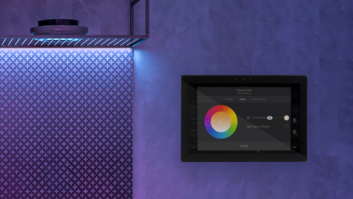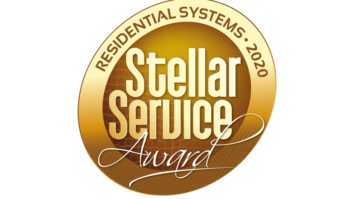That rumbling sound you hear isn’t one of your trucks coming back from an installation job. It’s the sound of an entire industry in transformation, as global technology and entertainment companies join the fray and technologies converge toward common standards.
Be a little bit afraid and whole lot excited. As these forces redefine the automation business, life as we know it is going to change for the independent installer/integrator. The good news is that the changes represent good opportunities for integrators who get ready for this new world.
As the automation industry shifts from closed, proprietary systems to networks based on industry-wide standards and protocols, the role of the installer/integrator is going to evolve right along with it. Instead of installing products from a small group of manufacturers, most installers will find opportunities building sub-networks and integrating devices from a wide variety of manufacturers (some of whom are entirely new players in the automation market).
Disconnected islands of automation are going to become a thing of the past as consumers demand better integration and new technologies make it much easier to tie everything together.
To capitalize on this opportunity, though, systems integrators will need to reexamine their business models, explore a wider range of product offerings and ramp up their skills in networking and Internet-related technologies. Installer/integrators who don’t make the transition are likely to be pushed into the low-profitability corners of the market and locked out of the mainstream. In a report released earlier this year, titled Home Automation Evolves: The Ascent of Smart Home Networks, industry analysts Cahners Instat identified the changes that are taking place in the automation market. The extensive list can be summarized in three words: pretty much everything.
The market environment is changing as consumers demand easier-to-use automation systems that are also more powerful and personalized. They want customized solutions for security, energy management, climate control and entertainment, but they’re already fed up with VCRs that aren’t smart enough to record the right program and alarm systems that go off when the cat wakes up. In other words, they want more capabilities but they don’t want to live in a tangle of raw technology.
On the supply side, new market entrants ranging from major computer and software companies to consumer electronics and entertainment companies are jockeying for position. Some of these companies have been keeping an eye on home automation from afar, waiting until the market is ready to take off. They see that happening now, and they’re ready to move.
With more players fighting for access to the home and the consumer, the integrator will play an even more critical role as the user advocate. Savvy consumers understand that all this incredible technology also has the potential to be incredibly complex and invasive, and they want to have somebody on their side.
Then there’s the technology. At every level from individual devices up to the Internet itself, the technology is progressing toward universal access and accommodation. Proprietary automation systems are being replaced by mainstream hardware and software, all built with Internet connectivity in mind. Consumers who know they can hop on the Internet, hook up to a computer halfway across the world and download their favorite music are starting to ask why automation devices halfway across the room can’t get along the same way. Everyone talks about “future-proof” technologies that can survive whatever the future throws at them, but what about your business? Are you ready to survive and succeed as the foundations of the industry shift under our collective feet?
Based on my years of experience as a systems integrator and on advice from other industry observers, future success in home automation integration rests on three key changes:
Move beyond a device-oriented installation business. With the push to make more devices user-installable (and new plug-and-play standards will accelerate this trend), it’s critical to lower your dependence on device installation services. Many integrators will welcome this change anyway, since device installation and maintenance chores are eating up profits.
Move toward systems integration business model.
Cahners Instat puts it succinctly in the report mentioned earlier: “The smart home is becoming the networked smart home.” Successfully planning, installing and maintaining these networks requires a new approach to the automation business. Yankee Group, another well-known market analysis firm, predicts 9.5 million networked homes by 2003, or about 8 percent of all U.S. households. Strategy Analytics expects that percentage to double by 2005, when 17 percent of all U.S. homes will have wired or wireless networks in place.
The ability to distribute broadband services throughout the home and the desire to connect multiple PCs and peripherals are key driving forces behind this growth.
Currently, 6.5 million households have broadband access, and according to Yankee, 42 percent of these consumers are interested in networking. Similarly, the number of homes with multiple PCs is expected to hit 28 million by 2003, according to Dataquest, and 40-70 percent (depending on the survey) of these households are interested in networking as well. Networking is clearly on its way to becoming a widespread consumer technology, and networking services will grow right along with it. Similarly, home automation demand is forecast to accelerate as well, as the technology evolves from proprietary products to mainstream hardware and software that is compatible with all these new networks. As Electronic News puts it, “Once the home network is populated with intelligent appliances, home automation will be just another client-server application.” In other words, the kind of application that requires mainstream networking and systems integration skills. Adopt a mainstream hardware and software technology strategy. The technology in these new smart home networks is the same technology found in the local area networks (LANs) found in most offices and in the global Internet. The key here is to be able to incorporate and integrate the widest possible range of capabilities for your customers. Between an Internet-friendly approach to networking and a device-independent software environment, you’ll be ready to support literally thousands of devices.
If we step back and survey the overall market dynamics, from new suppliers to new mainstream technology standards, several key trends are already shaping the nature of the installation/integration business.
Partnerships. These changes are making it easier to forge new relationships while lowering your reliance on existing partnerships and proprietary solutions. Without the constraints of a proprietary technology platform, you’ll be free to incorporate whatever mix of hardware and software is right for each installation.
Service skills. As more devices feature simple plug-and-play installation, demand is going to decrease for your lower-level installation services. At the same time, as networking begins to play an increasingly vital role in home automation, you’ll need an expanded set of programming and network engineering skills. While this shift may require changes in your staffing strategies, it is good news in several key respects. Training for these higher-level skills is much more widely available than for specialized skills in proprietary technologies. These higher-level skills also open up new business opportunities for you in network consulting and integration, with hourly rates considerably higher than those for installation services. Plus, these skill requirements make it easier to attract and keep top employees since they know they’re developing skills with wide applicability; you’re future-proofing your employees while you future-proof your business.
Profit and productivity. With remote-access, device-independent software and wide availability of mainstream networking skills, integrators will be better positioned for sustainable profitability. If both you and your customers are tired of paying for truck rolls just to change a single button on a touch panels, this will be a very welcome evolution.
Market Reach
Saving the best for last, these changes will help you expand both the depth and breadth of your customer base:
Because you’re no longer limited to the offerings of just a few manufacturers, you’ll be able to provide existing customers with even more-extensive solutions. In addition to automation controls, for instance, you can design, integrate and install all the computer networking and Internet connectivity that your clients need. Just as standardization and economies of scale drove PC prices down to mass-market levels in a few short years, they’re starting to drive automation prices down, too. Many integrators are already expanding their sights from the $1 million-plus market to homeowners in the $500,000 to $1 million range.
In addition to opening up a vastly larger market, this will also lower your dependence on high-end homeowners, many of whom have slashed discretionary spending after last year’s stock market adventures.
Lastly, home automation is finally ready to move beyond gadget enthusiasts to mainstream consumers. By shielding them from the complexity and putting them back in control, you’ll have a much more appealing solution for people who don’t live their lives in pursuit of the latest techno-toys.
You’ll need to make some changes to get there, to be sure, but the business advantages should make it more than worth the effort.
Where to Go from Here
Staying on top of trends and technology is nothing new for an integrator, of course, so it’s more a question of where to direct your research. It seems clear that mainstream networking is going to take over most home automation applications, and that means ethernet inside the home and the Internet on the outside. Wireless communications will play a key role as well.
Get to know the big new players in the industry as well, including the major software, computer, consumer electronics and media companies who want a share of the automation market.
Once you understand the implications of mainstream hardware, software and networking, consider the changes you’ll need to make to your business and marketing strategies. For example, a business built around device profits and $40/hour installation services looks quite different from a business built around systems integration and $100/hour consulting services.
While it may be impossible to accurately predict the precise impact of this much new money and new energy in an industry, we can safely say that things definitely aren’t going to stay the same. It’s going to be a wild ride, but installer/integrators who make the transition to can look forward to some exciting new opportunities.
Mike Wimberly is director of sales engineering for Premise Systems Inc.







